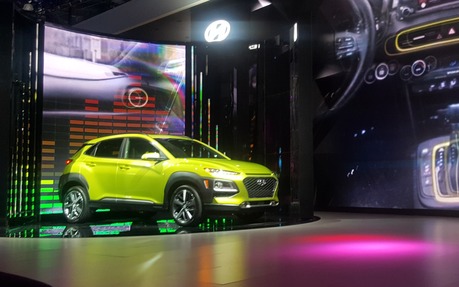2018 Hyundai Kona: Not Your Average (Cup of) Joe
If you only read one thing about the 2018 Hyundai Kona, let it be this: the new Korean subcompact SUV with a Hawaiian name features the same lime colour as its rival the Nissan Qashqai and looks essentially like a Subaru Crosstrek with mouldings along the bottom of its bodywork.
The rest is what you would expect. The 2018 Hyundai Kona (named after one of the world’s best coffee-producing regions) is the new baby SUV in in the lineup. It’s the kissing cousin of the Kia Stonic and will be available in Canadian dealerships by April.
- Also: The new Hyundai KONA unveiled
- Also: 2018 Hyundai Accent: A Mini Elantra That’s Subcompact to the Max
The base trim will be equipped with a 2.0-litre four-cylinder engine good for 147 horsepower and 132 lb.-ft. of torque. An optional turbocharged, 1.6-litre four cylinder will be available for those who’d be happier with 175 horsepower and 195 lb.-ft. of torque. That’s the same mill available in the Hyundai Tucson.
The more modest engine is paired with a six-speed automatic gearbox, while a seven-speed, dual-clutch automatic comes with the more powerful engine. The lack of a manual transmission leaves a gap, but at least we won’t be forced to put up with a continuously variable transmission.
Good news: all-wheel drive is available with either drivetrain. This isn’t just a bonus for winter, because the AWD versions will get a multilink independent rear suspension. The two-wheel-drive versions have a torsion bar instead, which is sure to add some bumps to your ride.
So how much will drivers have to shell out for a 2018 Hyundai Kona? The exact price hasn’t been released yet, though details should be forthcoming in time for the Montreal International Auto Show in mid-January. We expect the price to start around the $20,000 mark.
Since the Hyundai Kona is arriving late in the game, it’s going to have to hit hard if it wants to make an impact. After all, the subcompact SUV category is already chock-full of strong contenders, such as the Honda HR-V, Chevrolet Trax, Jeep Renegade, Mazda CX-3, Nissan Qashqai, Subaru Crosstrek and Toyota C-HR. (Did we forget any?)
True to Korean tradition, it will appeal to buyers with equipment and custom features that many competitors don’t offer.
Things to look for will include head-up display (the back-lit information you see at the bottom of a windshield) and a roof that’s a different colour than the rest of the vehicle body. This two-tone effect looks really good on the Kona’s press photos. It’s strange that the three units displayed at the LA Auto Show didn’t include this feature.
Maybe the Hyundai brass thought the black roof (which seems to float above the small frame) made the Kona look a little too much like the Toyota C-HR to really make waves at its North American debut?
Possibly, but I’d reassure them by saying that the Kona is much easier on the eyes than its Japanese rival, whose exterior is distinctly more tormented.
Did you know?
Since launching the Santa Fe prototype in 1999, Hyundai has been naming its models after geographic locations. Nearly 20 years later, they are still keeping up the tradition with this name that comes from Hawaii’s main island, where world-class coffee is grown.
